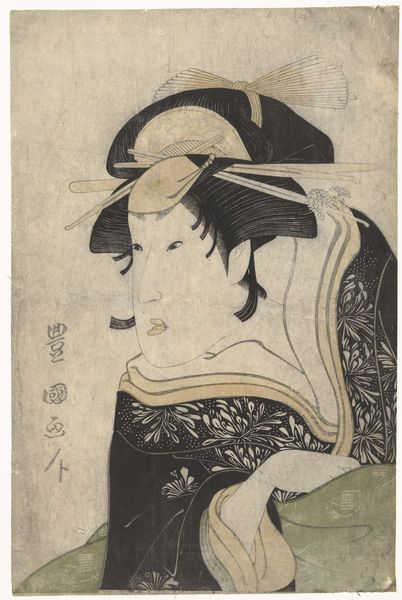
An Oiran Seated upon a Bed, Writing a Letter 1759 - 1779
0:00
0:00
drawing, print, ink
#
portrait
#
drawing
#
ink drawing
#
ink painting
# print
#
asian-art
#
ukiyo-e
#
japan
#
ink
Dimensions: H. 20 1/8 in. (51.5 cm); W. 4 1/2 in. (11.4 cm)
Copyright: Public Domain
Editor: This woodblock print, created between 1759 and 1779 by Suzuki Harunobu, depicts an Oiran seated on what appears to be a bed, writing a letter. The muted colors and the woman's downcast gaze give it a melancholic feel. How do you interpret this work within its historical context? Curator: It's crucial to understand that ukiyo-e prints like this weren't just decorative; they participated in a broader visual culture, shaping perceptions and sometimes even reinforcing hierarchies. The Oiran, a high-ranking courtesan, was a celebrity figure, and prints like these were essentially publicity, creating a market and sustaining a certain social image. The act of writing – do you think that reinforces or subverts those existing social dynamics? Editor: That's fascinating. I hadn't thought about it as publicity. Maybe writing humanizes her? It gives her agency beyond just being an object of beauty. Curator: Precisely. Literacy was highly valued and often associated with the elite. The act of writing suggests intellect, emotion, and connection, maybe even hints at complexities of their daily life. This touches on an interesting tension inherent in these prints – the exoticization of these women versus the humanizing details included in their portrayal. What purpose did representing such tension serve? Editor: I suppose it served to both attract and perhaps temper the male gaze, allowing for a more nuanced appreciation, and broader accessibility and appreciation. It's a push and pull between objectification and respect, maybe. Curator: Exactly. By showcasing the humanity of these figures, the prints created a space for a more socially conscious interaction with a controversial social dynamic, opening it to the gaze and assessment of wider audiences. Editor: This reframing is so helpful. I now understand how an ukiyo-e print serves as a tool for historical dialogue. Thanks for expanding my perspective. Curator: And you highlighted the fascinating tension within the piece itself. A good reminder that even seemingly straightforward images carry complex cultural weight.
Comments
No comments
Be the first to comment and join the conversation on the ultimate creative platform.













